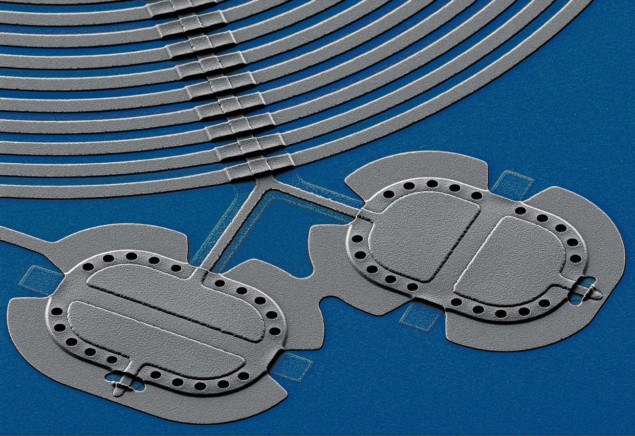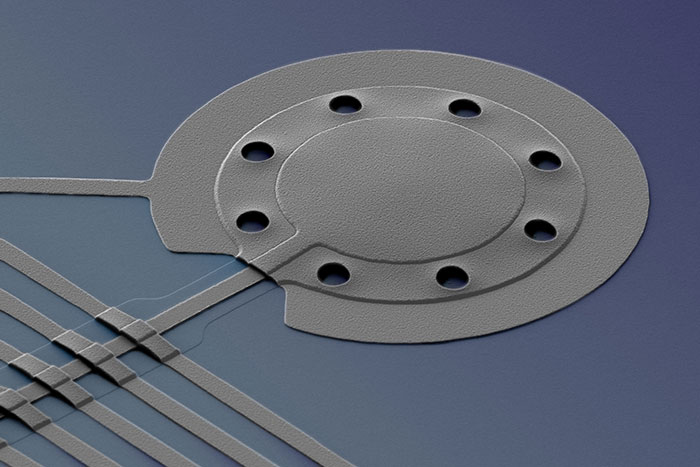
Quantum entanglement between two macroscopic vibrating drumheads has been demonstrated by two independent research groups. As well as being used to study the interface between the quantum and classical worlds, the systems could have practical applications in a range of quantum technologies.
Quantum mechanics was first developed to explain the behaviour of tiny objects such as subatomic particles and is still often described as the physics of the very small. Although quantum mechanics applies to everything regardless of its size, detecting quantum effects in large objects is difficult because of the blurring effects of both classical and quantum noise.
Always up for a challenge, physicists are keen to observe quantum phenomena on ever larger scales and now two independent teams have demonstrated the detection and manipulation of entanglement in vibrating aluminium membranes that resemble drumheads.
Quantum-free subspace
In one study, researchers in Finland and Australia used a trick first proposed by Eugene Polzik of the University of Copenhagen and others. They created a “quantum mechanics free subspace” in which they could make measurements that appeared to violate Heisenberg’s uncertainty principle. This famous principle that says that, as one cannot measure the state of a system without disturbing it (a phenomenon called quantum backaction), it is never possible to know both the position and momentum of an object beyond a certain degree of accuracy.
The team achieved this by measuring a specifically chosen resonant frequency between a pair of vibrating membranes (each about 10 micron across) in two separate microwave cavities, such that the quantum backaction was not visible in the signal, explains Mika Sillanpää of Aalto University in Finland, who led the research. “We select the one part in which we are interested in, but Heisenberg dictates that this backaction has to go somewhere,” says Sillanpää; “We put this backaction in the part of the system that we cannot see and which we don’t care about.” The researchers used this extraordinarily precise measurement to create and verify a stable entangled state between the two membranes. Sillanpää now hopes to use the technique to search for gravitational effects in quantum systems.
In the second study, researchers at the US National Institute for Standards and Technology (NIST) in Colorado, created entangled states between two 10 micron-scale membrane resonators in one cavity by simultaneously applying pulses of two different microwave frequencies. If the drums had responded independently to the pulses, the first would have been heated, whereas the second would have been cooled by Doppler cooling (a process used to laser-cool atoms).
Leaking information
However, the simultaneous pulses could also be used to entangle the motions of the membranes using the fact that one membrane interacts with photons generated by the oscillation of the other. “The entangling operation is a little bit more delicate because we want the membranes to strongly interact with each other, but at the same time we don’t want information about that entangled state coming out to the rest of the universe,” explains NIST’s John Teufel. “During the state preparation, you apply microwave pulses to do the entangling and then, when you want to verify, you apply microwave pulses to do the readout.”
In the measurement phase, the researchers measured the position and momenta of the two membranes at the same instant. After 10,000 repetitions, the researchers found that they were correlated so well that the two membranes must be entangled, as otherwise the predictability of the position and momenta of one membrane from those of the other would violate Heisenberg’s uncertainty principle.
“The position of one and the position of the other agrees much better than the diameter of a proton,” says team member Shlomi Kotler, now at the Hebrew University of Jerusalem.
Not just cute science
The researchers are now looking to build more complex networks of entangled resonators: “From a NIST technology perspective, these types of ideas are more than just cute science – they’re the technology you’d want to do quantum communication or quantum networking,” says Teufel.
Commenting on the two studies, Polzik describes them as “great work”. He adds, “To me the results are pretty similar and achieved by similar means in similar systems”. Polzik points out that the results complement work done by his team in 2020, which achieved photon-mediated entanglement between a millimetre-scale membrane and a distant atomic ensemble. He says that the spatial proximity of the mechanical resonators used in the two new studies means that perturbations to one are also likely to affect the other, which could limit research applications. He also points out that the systems could find use in local quantum information processing, perhaps as quantum memories.

Squeezed light plays a quantum drum
Aashish Clerk of the University of Chicago is also impressed with the studies but sees a crucial difference between them: “The Sillanpää experiment does really leverage these really neat backaction-evading measurements to get entanglement, and when they do they’re able to stabilize an entangled state,” he says. “That’s a good thing because the entanglement is just there waiting for you; it’s a bad thing because the system has forgotten anything about its initial state”. He adds, “The Teufel group do something like a two-qubit gate: when they do the entangling operation, the form of the entangled state they get depends on the states of the resonators to begin with. These are two different ways that both generate entanglement, but they’re different ways and they have different possible utility.”
The studies are described in separate papers in Science.



